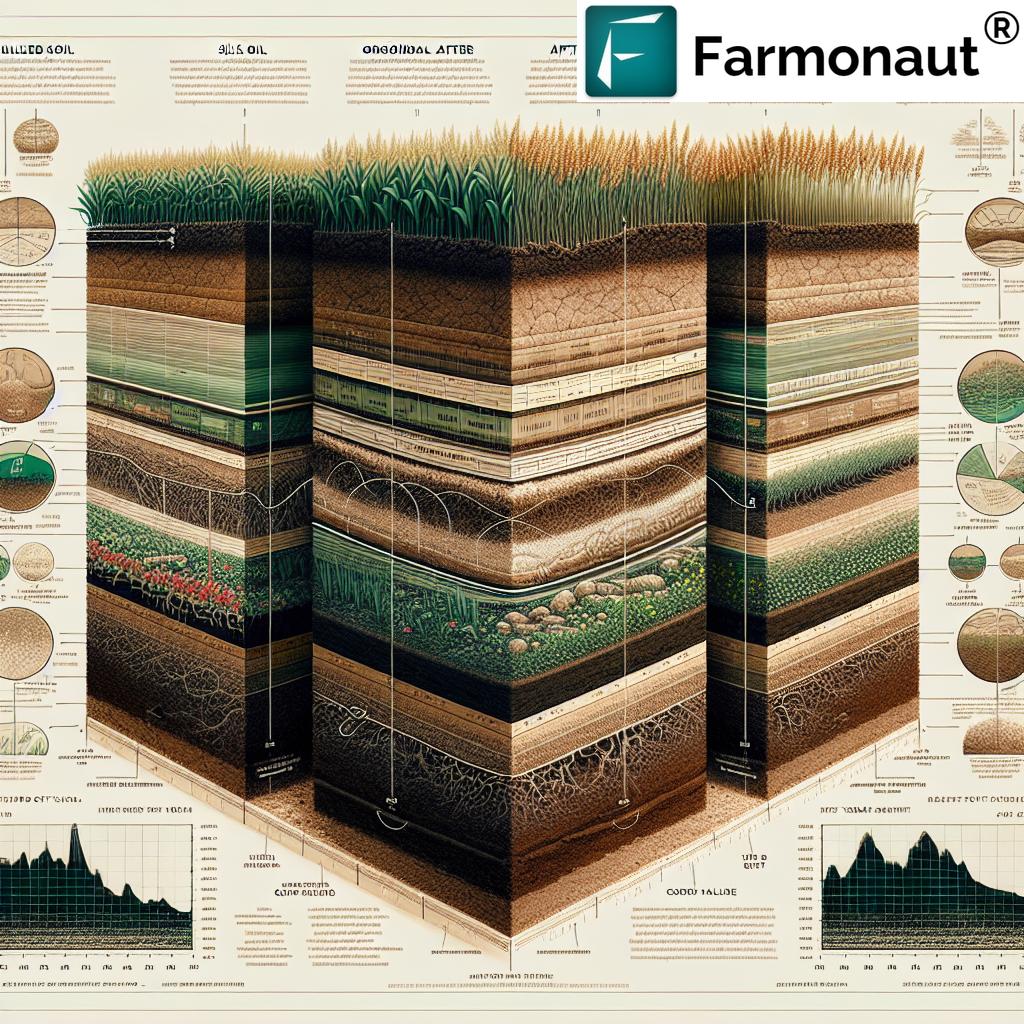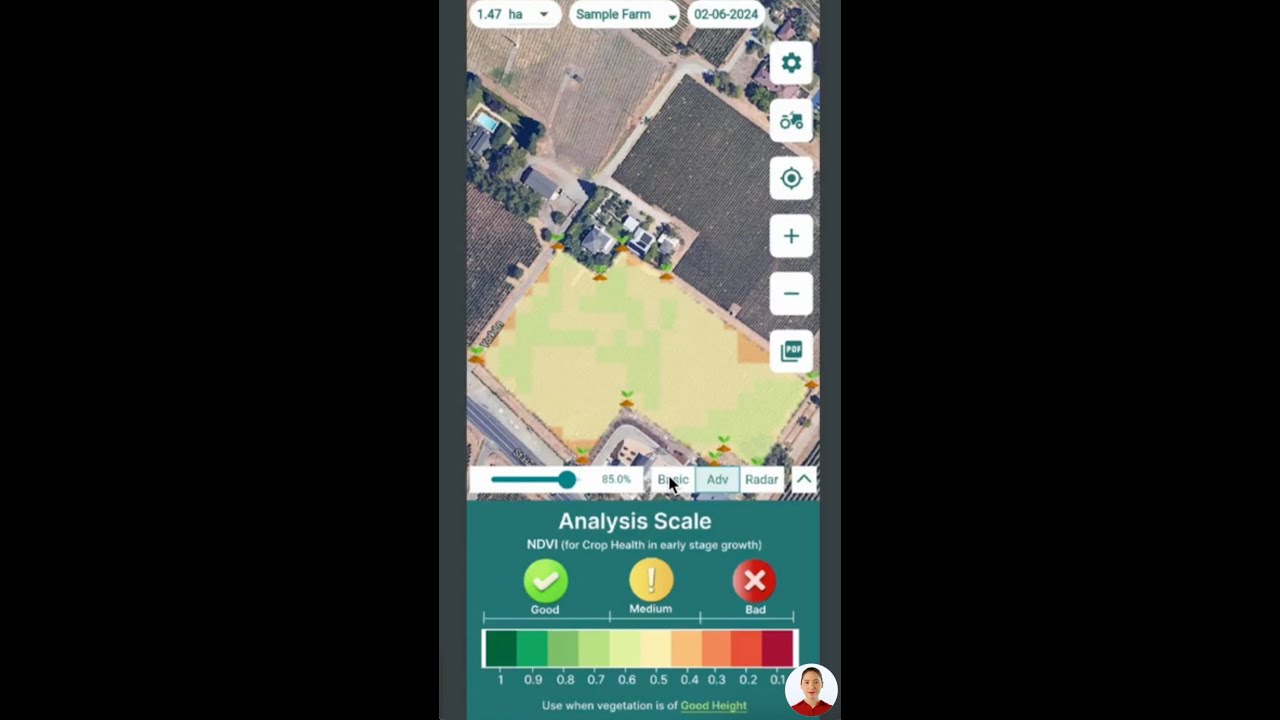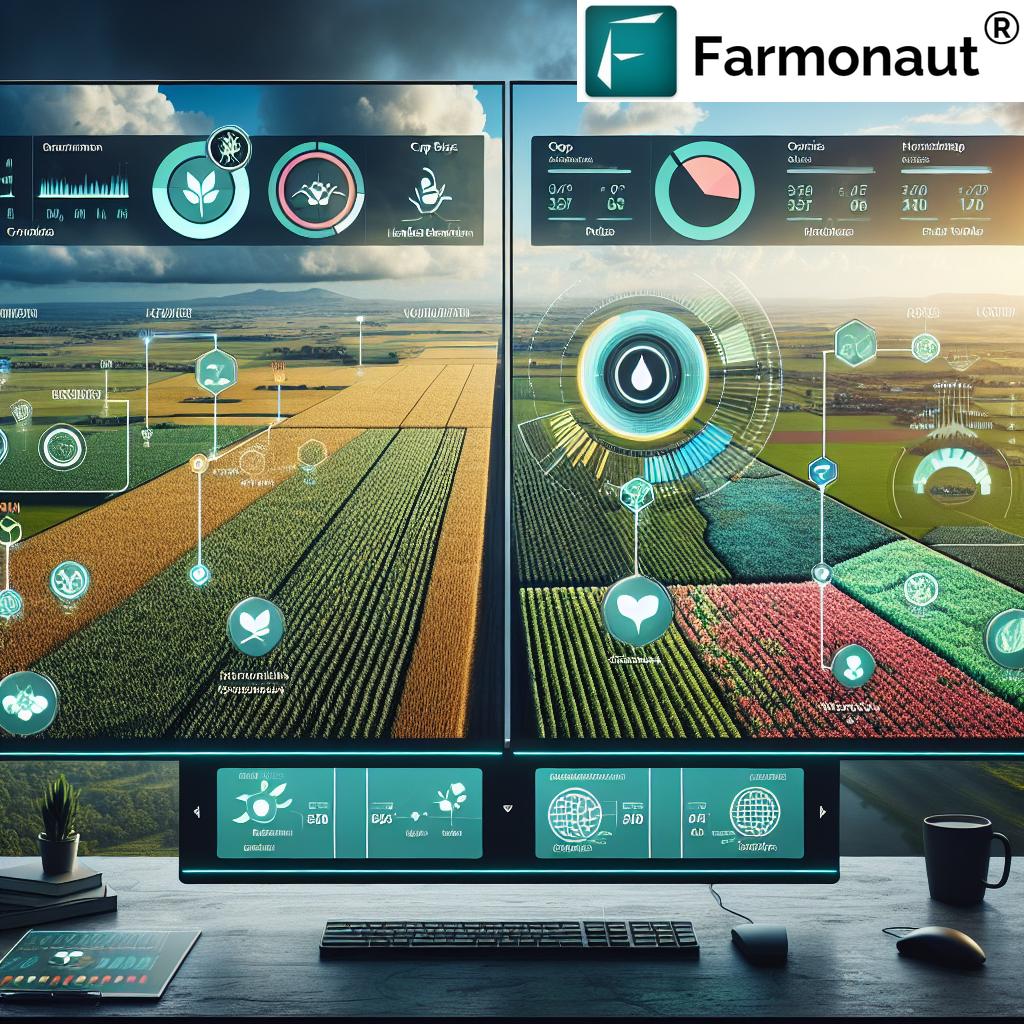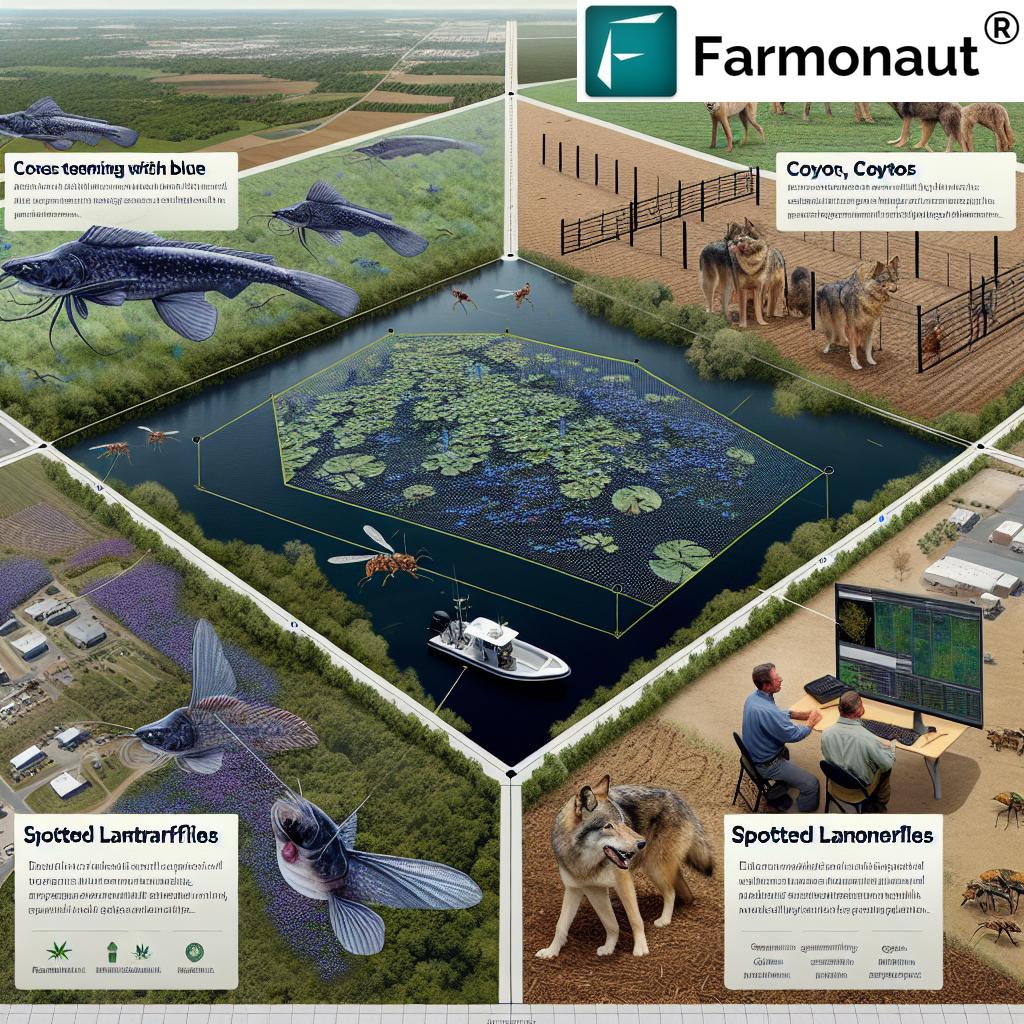Unlocking Sustainable Agriculture: One-Time Tillage Impact on No-Till Farming in Nebraska Revealed
“A five-year study in Nebraska revealed that one-time tillage in no-till systems can address phosphorus stratification without long-term yield impacts.”
In the ever-evolving world of agriculture, we at Farmonaut are constantly seeking innovative ways to enhance sustainable farming practices. Today, we’re excited to share groundbreaking research that sheds new light on the delicate balance between no-till farming and occasional tillage. This study, conducted over five years in eastern Nebraska, offers valuable insights into how farmers can optimize their soil health management strategies while maintaining the benefits of conservation agriculture.
The Quest for Sustainable Agriculture Practices
Sustainable agriculture has become more than just a buzzword; it’s a necessity in our quest to feed a growing global population while preserving our planet’s resources. No-till farming has long been hailed as a cornerstone of sustainable agriculture, offering numerous benefits such as improved soil structure, reduced erosion, and enhanced soil organic matter content. However, like any agricultural practice, it comes with its own set of challenges.
One such challenge is the stratification of nutrients, particularly phosphorus, in the upper layers of soil. This phenomenon can lead to reduced nutrient availability for crops and potential environmental issues. The question that has puzzled agronomists and farmers alike is: Can we address these issues without compromising the long-term benefits of no-till systems?

The Nebraska Study: A Game-Changer in Agronomy Research
The five-year study conducted in eastern Nebraska set out to answer this pressing question. Researchers investigated the impact of one-time tillage on crop yield optimization and soil properties in long-term no-till systems. The findings are nothing short of revolutionary, offering a nuanced perspective on the role of occasional tillage in sustainable agriculture.
Key Findings:
- One-time tillage can effectively address phosphorus stratification in no-till systems.
- The effects on soil properties are temporary, diminishing over time.
- Crop yields remain largely unaffected in the long term.
- Soil structure and overall health can be maintained with careful management.
These findings suggest that farmers can potentially have the best of both worlds – the long-term benefits of no-till farming combined with the ability to address specific soil issues through strategic, occasional tillage.
Understanding the Impact on Soil Properties
To fully appreciate the implications of this study, we need to delve deeper into how one-time tillage affects various soil properties. Let’s break it down:
Phosphorus Stratification
In no-till systems, phosphorus tends to accumulate in the upper layers of soil over time. This stratification can lead to reduced nutrient availability for crops, especially during dry periods when the topsoil moisture is limited. One-time tillage effectively redistributes phosphorus throughout the soil profile, making it more accessible to plant roots.
Soil Structure
One of the primary concerns with tillage is its potential to disrupt soil structure. However, the study revealed that when implemented carefully, one-time tillage had minimal long-term impact on soil structure. The key lies in the timing and method of tillage, ensuring that it’s done when soil conditions are optimal.
Organic Matter Content
Soil organic matter is crucial for soil health, water retention, and nutrient cycling. The research showed that while one-time tillage may cause a temporary decrease in surface organic matter, the overall impact on soil organic carbon was minimal over the five-year study period.
Microbial Activity
Soil microbes play a vital role in nutrient cycling and overall soil health. The study observed that microbial populations showed resilience to one-time tillage, with communities quickly rebounding to pre-tillage levels.
Implications for Crop Yield Optimization
Perhaps the most critical finding for farmers is the impact on crop yields. The study revealed that:
- Initial yield impacts were minimal.
- Long-term yields were not significantly affected by one-time tillage.
- In some cases, yields slightly improved due to better nutrient distribution.
This suggests that farmers can address soil issues through occasional tillage without sacrificing the yield benefits associated with no-till systems.
“Research shows that effects of occasional tillage on soil stratification in no-till farming diminish over time, maintaining soil health benefits.”
Balancing Conservation Agriculture with Practical Needs
The study’s findings highlight the importance of a balanced approach to sustainable agriculture. While conservation agriculture techniques like no-till farming offer numerous benefits, there may be instances where limited intervention is necessary. The key is to make these interventions strategic and minimal.
At Farmonaut, we understand the complexity of these decisions. Our precision agriculture technologies are designed to help farmers navigate these challenges by providing real-time data and insights.

Implementing Insights with Precision Agriculture
Implementing the insights from this study requires careful planning and precise execution. This is where Farmonaut’s suite of tools comes into play:
- Satellite-Based Crop Monitoring: Our advanced satellite imagery allows farmers to track soil health indicators and crop performance in real-time.
- AI-Powered Advisory: Our Jeevn AI system can help determine the optimal timing for interventions like one-time tillage based on soil conditions and crop needs.
- Resource Management Tools: Optimize your inputs and track the impact of management decisions on soil health and crop yields.
By leveraging these technologies, farmers can make data-driven decisions about when and how to implement occasional tillage in their no-till systems.
The Broader Impact on Sustainable Agriculture
The implications of this study extend far beyond the borders of Nebraska. As we face global challenges like climate change and food security, the need for sustainable yet productive agricultural practices has never been more critical. This research provides a blueprint for how we can fine-tune our approach to conservation agriculture, balancing environmental stewardship with the practical needs of modern farming.
Global Relevance
While the study was conducted in eastern Nebraska, its findings have global relevance. Farmers around the world grappling with similar challenges in no-till systems can draw valuable lessons from this research. The key is to adapt these insights to local conditions and farming systems.
Environmental Quality
One of the most significant aspects of this research is its implications for environmental quality. By maintaining the benefits of no-till farming while addressing specific soil issues, we can:
- Reduce soil erosion
- Improve water quality by minimizing nutrient runoff
- Enhance carbon sequestration in agricultural soils
- Promote biodiversity in agroecosystems
The Role of Technology in Implementing Research Findings
As we consider the practical application of these research findings, it’s clear that technology plays a crucial role. Farmonaut’s suite of tools is particularly well-suited to help farmers implement these insights:
- Precision Monitoring: Our satellite-based crop health monitoring system allows farmers to track soil conditions and crop performance with unprecedented accuracy. This data is crucial for determining when and where one-time tillage might be beneficial.
- AI-Driven Decision Support: The Jeevn AI advisory system can analyze complex data sets, including soil properties, weather patterns, and crop performance, to provide tailored recommendations on tillage practices.
- Resource Optimization: Our platform helps farmers optimize their use of inputs, ensuring that any tillage intervention is as efficient and effective as possible.
By leveraging these technologies, farmers can implement the study’s findings with precision, maximizing the benefits while minimizing any potential drawbacks.
Comparing No-Till and One-Time Tillage Effects
To better understand the implications of the study, let’s examine a comparison of continuous no-till farming versus implementing one-time tillage in a no-till system:
| Soil Property | Continuous No-Till | One-Time Tillage |
|---|---|---|
| Phosphorus Stratification | High (Year 1-5) | Low (Year 1), Medium (Year 3), High (Year 5) |
| Soil Structure | Excellent (Year 1-5) | Good (Year 1), Very Good (Year 3-5) |
| Erosion Risk | Low (Year 1-5) | Medium (Year 1), Low (Year 3-5) |
| Organic Matter Content | High (Year 1-5) | Medium (Year 1), High (Year 3-5) |
| Crop Yield | Stable (Year 1-5) | Stable (Year 1-5) with potential slight increase |
This table illustrates how the effects of one-time tillage on various soil properties change over time, eventually converging with the benefits of continuous no-till farming. It’s a visual representation of the study’s key finding: that strategic, occasional tillage can address specific issues without compromising the long-term benefits of no-till systems.
Practical Considerations for Farmers
While the study’s findings are promising, it’s important for farmers to consider several factors before implementing one-time tillage in their no-till systems:
- Soil Type: The effects of tillage can vary depending on soil texture and structure. Sandy soils, for instance, may respond differently than clay soils.
- Climate: Local climate conditions play a crucial role in determining the impact of tillage. Areas with high rainfall or prone to erosion may require extra caution.
- Crop Rotation: The type of crops in rotation can influence the decision to till. Some crops may benefit more from nutrient redistribution than others.
- Timing: The timing of tillage is critical. It should be done when soil conditions are optimal to minimize compaction and maximize benefits.
- Equipment: Using the right tillage equipment is essential to achieve the desired results without causing unnecessary soil disturbance.
Farmonaut’s precision agriculture tools can assist in evaluating these factors, providing data-driven insights to inform decision-making.
The Future of Sustainable Agriculture
As we look to the future, it’s clear that sustainable agriculture will continue to evolve. The findings from this Nebraska study represent a significant step forward in our understanding of how to balance conservation practices with the practical needs of modern farming. Here are some key takeaways for the future of sustainable agriculture:
- Adaptive Management: The study underscores the importance of adaptive management in agriculture. Farmers must be willing to adjust their practices based on the latest research and site-specific conditions.
- Integrated Approaches: The future of sustainable agriculture lies in integrating various practices and technologies. No single approach will be a silver bullet for all challenges.
- Data-Driven Decision Making: As demonstrated by Farmonaut’s technologies, the role of data in agriculture will only grow. Farmers who leverage data-driven insights will be better positioned to optimize their operations.
- Continued Research: This study opens up new avenues for research. Future studies might explore the long-term impacts of periodic tillage or investigate how these findings apply to different crops and regions.
At Farmonaut, we’re committed to staying at the forefront of these developments, continually updating our technologies to provide farmers with the most advanced tools for sustainable agriculture.
Conclusion: A Balanced Approach to Sustainable Farming
The groundbreaking study from Nebraska offers a nuanced perspective on the role of tillage in no-till systems. It challenges the binary thinking of “till vs. no-till” and suggests that a more flexible, strategic approach can yield optimal results. By carefully implementing occasional tillage, farmers can address specific soil issues while maintaining the long-term benefits of conservation agriculture.
As we move forward, the key to sustainable agriculture will be balance and precision. Farmonaut’s suite of precision agriculture technologies is designed to help farmers navigate these complex decisions, providing real-time data and AI-driven insights to optimize their farming practices.
By embracing this balanced approach and leveraging advanced technologies, we can work towards a future where agriculture is both highly productive and environmentally sustainable. The findings from this study are not just academic – they offer a practical roadmap for farmers looking to optimize their soil health management strategies and boost crop yields sustainably.
As we continue to unlock the secrets of sustainable agriculture, one thing is clear: the future of farming lies in intelligent, data-driven practices that respect the delicate balance of our agricultural ecosystems.
FAQs
- Q: What is the main finding of the Nebraska study on no-till farming?
A: The study found that occasional one-time tillage in no-till systems can address issues like phosphorus stratification without long-term adverse effects on yields or soil structure. - Q: How long did the study in Nebraska last?
A: The research was conducted over a five-year period in eastern Nebraska. - Q: Does one-time tillage affect crop yields in no-till systems?
A: According to the study, crop yields remain largely unaffected in the long term after implementing one-time tillage in no-till systems. - Q: What is phosphorus stratification, and why is it a concern?
A: Phosphorus stratification is the accumulation of phosphorus in the upper layers of soil, which can lead to reduced nutrient availability for crops, especially during dry periods. - Q: How can Farmonaut’s technology help farmers implement these research findings?
A: Farmonaut offers precision agriculture technologies like satellite-based crop monitoring, AI-powered advisory systems, and resource management tools that can help farmers make data-driven decisions about when and how to implement occasional tillage. - Q: Are the effects of one-time tillage permanent?
A: No, the study shows that the effects of occasional tillage on soil stratification diminish over time, allowing the soil to return to its no-till equilibrium. - Q: Is one-time tillage recommended for all no-till farms?
A: Not necessarily. The decision to implement one-time tillage should be based on specific farm conditions, soil type, climate, and crop needs. It’s important to consult with agronomic experts and use precision agriculture tools to make informed decisions. - Q: How does one-time tillage impact soil organic matter?
A: While one-time tillage may cause a temporary decrease in surface organic matter, the study found that the overall impact on soil organic carbon was minimal over the five-year study period. - Q: Can one-time tillage help with other soil issues besides phosphorus stratification?
A: While the study focused primarily on phosphorus stratification, one-time tillage may also help address other issues such as compaction or incorporation of surface-applied amendments. However, more research may be needed to fully understand its impact on other soil properties. - Q: How often can one-time tillage be implemented in a no-till system?
A: The study focused on a single instance of tillage over a five-year period. The frequency of tillage in a no-till system should be minimized to maintain the benefits of no-till farming. Decisions about repeated tillage should be based on careful soil monitoring and agronomic advice.




















